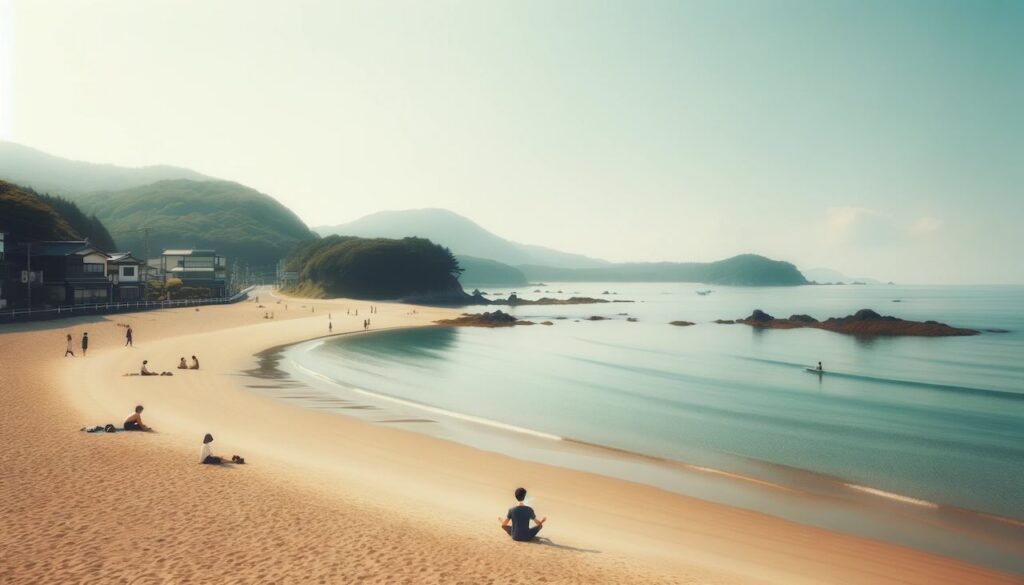When travelers think of Japan’s beaches, images of Okinawa’s tropical islands or Shonan’s surf spots near Tokyo often come to mind. Yet tucked quietly along the Sea of Japan, Shimane Prefecture offers an entirely different kind of coastal charm — one deeply rooted in Japanese mythology, seasonal beauty, and a lesser-known side of Japan’s natural diversity.
Why Shimane’s Coast Is Unique
Situated along Japan’s western coastline, facing the Sea of Japan, Shimane’s beaches experience distinct seasonal changes that shape both the landscape and local culture:
- Cooler ocean temperatures year-round compared to southern Japan.
- Dramatic seasonal transitions, from tranquil summer waters to wild winter waves.
- Rich marine biodiversity fueled by the interplay of warm and cold currents.
- Deep historical and spiritual significance, including ties to ancient Shinto mythology.
Unlike Japan’s more commercialized beach destinations, Shimane remains a relatively undiscovered coastal haven — offering visitors a peaceful and authentic experience of Japan’s rugged seascapes.
The Sea of Japan’s Four Seasonal Faces in Shimane
Spring (March–May): The Awakening Coastline
As winter retreats, Shimane’s coastline begins to bloom:
- Sea temperatures rise from around 12°C (54°F) to 17°C (63°F).
- While still too chilly for swimming, this is prime time for coastal walks, shell collecting, and exploring tidal pools teeming with early-season marine life.
- The nutrient-rich waters attract fish, birds, and shellfish — a paradise for nature photographers and birdwatchers.
- Visit nearby Izumo Taisha Shrine, one of Japan’s oldest and most sacred Shinto sites, where mythology and the sea intertwine.
Summer (June–August): A Refreshing Alternative to Tropical Beaches
Summer is peak season for beachgoers in Shimane:
- Water temperatures rise to a comfortable 25–27°C (77–81°F).
- Popular beaches like Inasa Beach (Izumo City) and Iwami Seaside Park (Hamada City) offer safe swimming, beach games, and stunning sunsets.
- The slightly cooler waters of the Sea of Japan are refreshing during Japan’s humid summer.
- Surfing, snorkeling, and kayaking are ideal — though a light wetsuit may help for extended water activities.
Autumn (September–November): Surfers’ Paradise and Tranquil Shores
As crowds thin, autumn transforms the coastline:
- Water temperatures range between 18–25°C (64–77°F).
- Surfing season reaches its peak, as seasonal swells arrive from the Sea of Japan.
- The beaches remain warm enough for wetsuit-protected water sports into November.
- Fall foliage in nearby coastal mountains creates breathtaking backdrops.
Winter (December–February): The Wild Sea of Japan
In winter, Shimane reveals its most dramatic face:
- Temperatures drop to 11–14°C (52–57°F).
- While swimming is out of the question, this is the season for contemplative beauty.
- Rough seas create towering waves and breathtaking coastal views, ideal for photographers and storm-watchers.
- Migratory seabirds and fishing boats add life to the winter coastline.
Shimane’s Coastal Highlights
| Beach | Notable Features |
|---|---|
| Inasa Beach (Izumo City) | Mythological significance; believed to be where Shinto gods gathered. |
| Senjojiki Beach (Oda City) | Striking rock formations, crystal-clear water, excellent for photography. |
| Iwami Seaside Park (Hamada City) | Long sandy stretch, family-friendly, great for swimming and picnics. |
| Hanenishi Coast (Gotsu City) | Quiet, secluded spot ideal for nature lovers and tranquil walks. |
| Oda Coast (Masuda City) | Calm waves, great for families and scenic relaxation. |
Many of these beaches are far less crowded than Japan’s better-known coastal resorts, offering a chance to experience Japan’s quieter, more reflective coastal traditions.
The Ecological Richness of Shimane’s Waters
Shimane’s coastal ecosystems are shaped by a unique mix of ocean currents:
- The Tsushima Current, a branch of the Kuroshio Current, brings warm water northward.
- Cold currents mix with the warm flow, creating nutrient-rich upwelling zones.
- This supports a rich marine biodiversity where both warm-water and cold-water species coexist.
- Seasonal seafood — including squid, crabs, and mackerel — fills local markets, reflecting the sea’s bounty.
The balance of these currents makes Shimane’s coast a living laboratory of marine life, treasured by both scientists and local fishermen.
Safety and Seasonal Considerations
- Always check local surf and weather conditions before entering the Sea of Japan, especially in winter when conditions can change rapidly.
- Rip currents and strong offshore winds are common, so follow lifeguard instructions where available.
- Wetsuits are strongly recommended for water activities outside peak summer.
A Cultural and Natural Alternative for Travelers
While Shimane may lack the tropical allure of Okinawa, it offers something far rarer: a genuine connection to Japan’s spiritual and natural rhythms. Here, you’re not just visiting a beach — you’re stepping into an ancient cultural landscape shaped by the sea and its seasons.
From the legends of Izumo to the quiet drama of winter waves, Shimane invites visitors to experience a quieter, more contemplative side of Japan’s coastal beauty.
Summary
Shimane’s coast along the Sea of Japan offers a year-round display of seasonal transformations, blending mythology, nature, and tranquility. With fewer crowds and an authentic atmosphere, this region provides travelers with a uniquely Japanese seaside experience — one where the rhythm of the waves echoes centuries of tradition.


